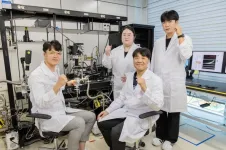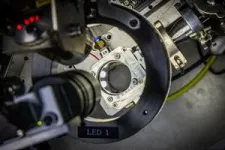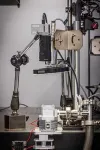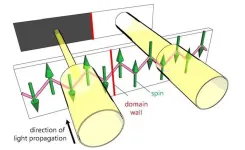(Press-News.org) The research team led by Dr. Daeho Kim and Dr. Jong Hwan Park at the Nano Hybrid Technology Research Center of the Korea Electrotechnology Research Institute (KERI) has developed a groundbreaking process technology that enables for ultrafast, 30-second preparation of hard carbon anodes for sodium-ion batteries using microwave induction heating.
One of the next-generation secondary batteries, the sodium-ion battery uses sodium (Na) in lieu of the current mainstay, lithium (Li). Sodium, the main component of salt, is more than a thousand times more abundant than lithium and is easier to extract and refine. Furthermore, its lower reactivity compared to lithium means greater electrochemical stability when used for batteries, making it more favorable for fast charging and discharging, while maintaining performance even at low temperatures.
Despite these advantages, sodium-ion batteries face significant challenges, including lower energy density and shorter lifespan compared to lithium-ion batteries due to the complexity of the manufacturing process. The larger size of sodium ions compared to lithium necessitates the use of hard carbon, which has a larger interlayer spacing than graphite, the current mainstay of anode materials.
Hard carbon is not found in nature and therefore must be synthesized. The preparation process is highly intricate, requiring hydrocarbon materials—main components of plants and polymers—to be heated in an oxygen-free environment at temperatures exceeding 1,000°C for extended periods. This “carbonization” process is both economically and environmentally burdensome, which has been a key obstacle to the commercialization of sodium-ion batteries.
Among the many teams trying to address this challenge, the team led by Dr. Kim and Dr. Park proposed a rapid heating method using microwave technology, which we can easily find from a microwave oven in the kitchen. They first created films by mixing polymers with a small amount of highly conductive carbon nanotubes*. They then applied a microwave magnetic field to the films to induce currents in the carbon nanotubes, selectively heating the films to over 1,400°C in just 30 seconds.
* Carbon Nanotubes: Carbon nanomaterials are conductive materials at the nanoscale, composed of carbon arranged in hexagonal honeycomb patterns. These materials include graphene, which has a two-dimensional planar structure, and carbon nanotubes, which are helical cylinder forms of graphene. Carbon nanotubes exhibit electrical and thermal conductivity comparable to copper, and their strength is approximately 100 times that of steel, making them a highly promising material for next-generation applications.
Through years of research, KERI has developed a technology to uniformly heat-treat conductive thin films, such as metals, using microwave magnetic fields. This technology has attracted considerable attention in industrial processes such as displays and semiconductors. KERI's Nano Hybrid Technology Research Center is recognized as the nation's leading center for carbon nanomaterials technology. Dr. Kim and Dr. Park leveraged the center's capabilities to venture into sodium-ion battery anode materials and achieved promising results.
The key to their success lies in the team's own "multiphysics simulation" technique. It allowed them to have a profound understanding of the complex processes occurring when an electromagnetic field in the microwave bandwidth is applied to nanomaterials, leading to the creation of a novel process for preparing sodium-ion battery anode materials. The significance of the team’s findings has been demonstrated by the recent publication of their results in the prestigious Chemical Engineering Journal (IF: 13.3, ranked in the top 3% by JCR). The paper was co-first-authored by Geongbeom Ryoo and Jiwon Shin, student researchers who participated in KERI’s academia-research collaborative research program.
“Due to recent electric vehicle fires, there has been growing interest in sodium-ion batteries that are safer and function well in colder conditions. However, the carbonization process for anodes has been a significant disadvantage in terms of energy efficiency and cost,” said Dr. Jong Hwan Park. Dr. Daeho Kim added: “Our microwave induction heating technology enables fast and easy preparation of hard carbon, which I believe will contribute to the commercialization of sodium-ion batteries.”
Moving forward, the team plans to continue working to improve the performance of their anode materials and develop technology for the continuous mass production of large-area hard carbon films. They also see the potential of their microwave induction heating technology applicable to other fields, such as all-solid-state batteries that require high-temperature sintering, which warrants further research.
KERI, having already completed a domestic patent application, expects this technology to attract significant interest from companies involved in energy storage materials and anticipates technology transfer deals with potential industry partners.
<KERI is a government-funded research institute under the National Research Council of Science and Technology of the Korean Ministry of Science and ICT.>
END
A quick and easy way to produce anode materials for sodium-ion batteries using microwaves
2024-10-11
ELSE PRESS RELEASES FROM THIS DATE:
‘Inside-out’ galaxy growth observed in the early universe
2024-10-11
Astronomers have used the NASA/ESA James Webb Space Telescope (JWST) to observe the ‘inside-out’ growth of a galaxy in the early universe, only 700 million years after the Big Bang.
This galaxy is one hundred times smaller than the Milky Way, but is surprisingly mature for so early in the universe. Like a large city, this galaxy has a dense collection of stars at its core but becomes less dense in the galactic ‘suburbs’. And like a large city, this galaxy is starting to sprawl, with star formation accelerating in the outskirts.
This is the earliest-ever detection of inside-out galactic growth. ...
Protein blocking bone development could hold clues for future osteoporosis treatment
2024-10-11
Scientists have identified a protein that blocks the activity of bone-forming cells (osteoblasts) by stopping them from maturing during the journey to sites of bone formation, a new study has found.
In a paper published in Communications Biology today (Friday 11 October 2024), a team of researchers led by Dr Amy Naylor and Professor Roy Bicknell along with their team including Dr Georgiana Neag from the University of Birmingham have found that protein CLEC14A, which is found on blood vessel cells called endothelial ...
A new method makes high-resolution imaging more accessible
2024-10-11
A classical way to image nanoscale structures in cells is with high-powered, expensive super-resolution microscopes. As an alternative, MIT researchers have developed a way to expand tissue before imaging it — a technique that allows them to achieve nanoscale resolution with a conventional light microscope.
In the newest version of this technique, the researchers have made it possible to expand tissue 20-fold in a single step. This simple, inexpensive method could pave the way for nearly any biology lab to perform nanoscale imaging.
“This democratizes imaging,” says Laura Kiessling, the Novartis Professor ...
Tiny magnetic discs offer remote brain stimulation without transgenes
2024-10-11
Novel magnetic nanodiscs could provide a much less invasive way of stimulating parts of the brain, paving the way for stimulation therapies without implants or genetic modification, MIT researchers report.
The scientists envision that the tiny discs, which are about 250 nanometers across (about 1/500 the width of a human hair), would be injected directly into the desired location in the brain. From there, they could be activated at any time simply by applying a magnetic field outside the body. The new particles could quickly find applications in biomedical research, and eventually, after sufficient testing, ...
Illuminating quantum magnets: Light unveils magnetic domains
2024-10-11
When something draws us in like a magnet, we take a closer look. When magnets draw in physicists, they take a quantum look.
Scientists from Osaka Metropolitan University and the University of Tokyo have successfully used light to visualize tiny magnetic regions, known as magnetic domains, in a specialized quantum material. Moreover, they successfully manipulated these regions by the application of an electric field. Their findings offer new insights into the complex behavior of magnetic materials at the quantum level, paving the way for future technological advances.
Most of us are familiar with magnets that stick to metal surfaces. But what about those that do not? Among ...
Different types of teenage friendships critical to wellbeing as we age, scientists find
2024-10-11
Being a teenager is hard, confusing — and crucially important. Scientists studying teenage socializing have found that teenaged friendships could lay essential foundations for wellbeing in later life, and that not just the kinds of friendships teenagers experience but the timing of those friendships is critical.
“A teen’s perception of how broadly socially accepted they are by their peers in early adolescence is particularly influential in predicting adult wellbeing,” said Emily Shah of the University of Arkansas, first author of the article in Frontiers in Developmental Psychology. “Conversely, in late adolescence, the quality of their more ...
Hawaii distillery project wins funding from Scottish brewing and distilling award
2024-10-11
Hawaii could soon be welcoming a new distillery after a postgraduate student at Scotland’s Heriot-Watt University won a prestigious entrepreneurial award.
Canadian student Ethan Wang, 42, wants to open a new distillery on Hawaii’s scenic volcanic island of Maui and said he was in “total shock” after winning cash and support from an industry membership organisation to help make his idea happen.
The award, called the Worshipful Company of Distillers’ Entrepreneurship Award, is designed to help students apply their science in the real world and is run jointly by Heriot-Watt’s respected International Centre for Brewing and Distilling and The Worshipful Company ...
Trinity researchers find ‘natural killer’ cells that live in the lung are ready for a sugar rush
2024-10-11
Trinity researchers find ‘natural killer’ cells that live in the lung are ready for a sugar rush
Trinity College Dublin researchers, based at St James’s Hospital have provided important insights into the behaviour and metabolic function of a previously largely unknown, but crucial ‘natural killer’ (NK) immune cell resident in the lungs. Their findings, published today [Thursday, 10th October 2024] in the journal: Proceedings of the National Academy of Sciences (PNAS) provide ...
$7 Million from ARPA-H to tackle lung infections through innovative probiotic treatment
2024-10-11
University of California San Diego and University of California Berkeley researchers have been awarded up to $7 million from the Advanced Research Projects Agency for Health (ARPA-H) to conduct research under the PROTECT project — Pro/Prebiotic Regulation for Optimized Treatment and Eradication of Clinical Threats. The project targets pathogens such as Pseudomonas aeruginosa and potentially Staphylococcus aureus, which pose significant health risks for individuals with cystic fibrosis and those dependent on respirators. PROTECT co-principal investigators are ...
Breakdancers may risk ‘headspin hole’ caused by repetitive headspins, doctors warn
2024-10-10
Breakdancers may be at risk of developing a condition caused by repeatedly doing a cardinal move of their practice and performance—the headspin—warn doctors in the journal BMJ Case Reports.
Dubbed the ‘headspin hole,’ or ‘breakdance bulge,’ the condition is unique to breakdancers, and appears as a protruding lump on the scalp, often accompanied by hair loss and tenderness.
Breakdancers are particularly prone to injuries because of the complexities and physical demands of the moves, note the authors. Sprains, strains, and tendinitis are particularly common. Head and brain injuries, including subdural haematomas (pooling ...






